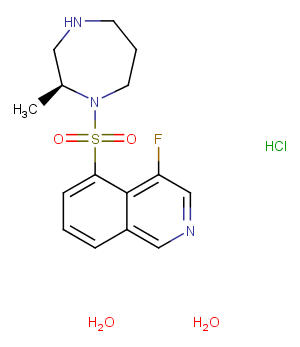产品信息
Ripasudil (K-115) hydrochloride dihydrate is a specific ROCK inhibitor (IC50s: 51/19 nM for ROCK1/ROCK2).
|
CAS号
|
887375-67-9 |
| 分子式 |
C15H23ClFN3O4S |
| 主要靶点 |
ROCK |
| 主要通路 |
细胞骨架|干细胞|细胞周期 |
| 分子量 |
395.88 |
| 纯度 |
99.28%, 此纯度可做参考,具体纯度与批次有关系,可咨询客服 |
| 储存条件 |
Powder: -20°C for 3 years | In solvent: -80°C for 1 year |
| 别名 |
Ripasudil hydrochloride dihydrate|瑞舒地尔盐酸二水合物|K-115 |
靶点活性
ROCK1:51 nM|ROCK2:19 nM|CaMKIIa:370 nM|PKC:27 μM|PKACa:2.1 μM
体内活性
Ripasudil reduces intraocular pressure in a concentration-dependent manner at concentrations between 0.1% and 0.4% in monkey eyes and 0.0625% to 0.5% in rabbit eyes, respectively [1]. Ripasudil (1 mg/kg, p.o. daily) shows a neuroprotective effect on retinal ganglion cells (RGCs) after nerve crush (NC). Ripasudil also inhibits the oxidative stress induced by axonal injury in mice. Ripasudil suppresses the time-dependent production of ROS in RGCs after NC injury [3].
体外活性
Ripasudil shows less potent inhibitory activities against CaMKIIα, PKACα, and PKC (IC50s: 370 nM, 2.1 μM and 27 μM) [1]. Ripasudil (1, 10 μM) induces cytoskeletal changes, including retraction and cell rounding and reduced actin bundles of cultured trabecular meshwork (TM) cells. Ripasudil (5 μM) significantly reduces transendothelial electrical resistance (TEER) and increases FITC-dextran permeability in Schlemm's canal endothelial (SCE) cell monolayers [2].
溶解度
细胞实验
Trabecular meshwork (TM) cells are plated on 6 well plates at a density of 1?×?10^4 cells per well in DMEM containing 10% FBS. Following overnight culture, when cells have reached semiconfluence, 1 or 10?μM of Ripasudil, 10?μM of Y-27632, or 10?μM of fasudil are added to culture wells. PBS is used as a control vehicle. After 60?min, drug solutions are removed and replaced with DMEM containing 10% FBS. Cells are observed by phase-contrast microscopy and photographed 60?min after drug application and 2?h after drug removal. For immunohistochemistry, TM cells are plated on gelatin-coated 8 well chamber slides at a density of 1?×?10^4 cells per well in DMEM containing 10% FBS. After overnight culture, when cells reach semiconfluence, cells are incubated in Ripasudil at 1 or 10?μM, Y-27632 at 10?μM, or fasudil at 10?μM for 60?min. PBS is used as a control vehicle. Drug solutions are removed and replaced with DMEM containing 10% FBS after 2?h. Cells are fixed with 4% paraformaldehyde in PBS for 15?min then washed with cytoskeletal buffer (10?mM MES, 150?mM NaCl, 5?mM EGTA, 5?mM MgCl2, 5?mM glucose, pH 6.1) and serum buffer (10% FBS in PBS). Cells are permeabilized with 0.5% Triton X-100 in PBS for 12?min at room temperature and blocked with serum buffer for at least 2?h at 4°C. Filamentous actin (F-actin) is labeled with 0.05?mg/mL Phalloidin-TRITC for 1?h at room temperature. After washing with PBS, cells are mounted with a commercial mounting medium containing DAPI and observed using a fluorescence microscope. The exposure to take images for F-actin and DAPI are 0.1 and 0.05?sec, respectively [2].
动物实验
In the rabbit experiments, 50 mL of vehicle or Ripasudil at concentrations of 0.0625%, 0.125%, 0.25, or 0.5% is instilled into one eye. Intraocular pressure (IOP) is measured in both eyes before and 0.5, 1, 2, 3, 4, and 5 h after instillation. The contralateral eye is not treated. Animals are administered all concentrations of Ripasudil assigned using the Latin square method with intervals of at least 2 d. In the monkey experiments, 20 mL of Ripasudil at concentrations of 0.1%, 0.2%, or 0.4%, and latanoprost at a concentration of 0.005% are instilled into one eye. IOP is measured in both eyes before and 1, 2, 4, 6, and 8 h after instillation. The contralateral eye is not treated. Animals are arranged to receive all formulations with intervals of at least 1 week using the Latin square method. The IOPs are compared with the results for the instillation side at pre-dose and at each time point after the instillation of Ripasudil and are compared with both eyes at each time point.

